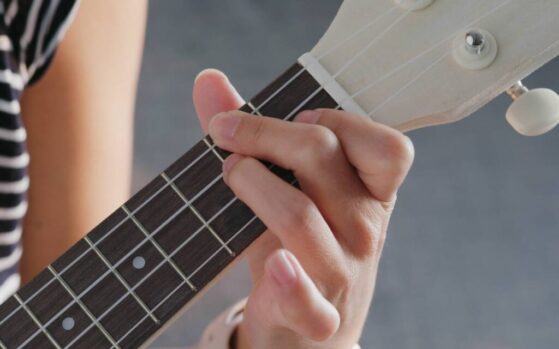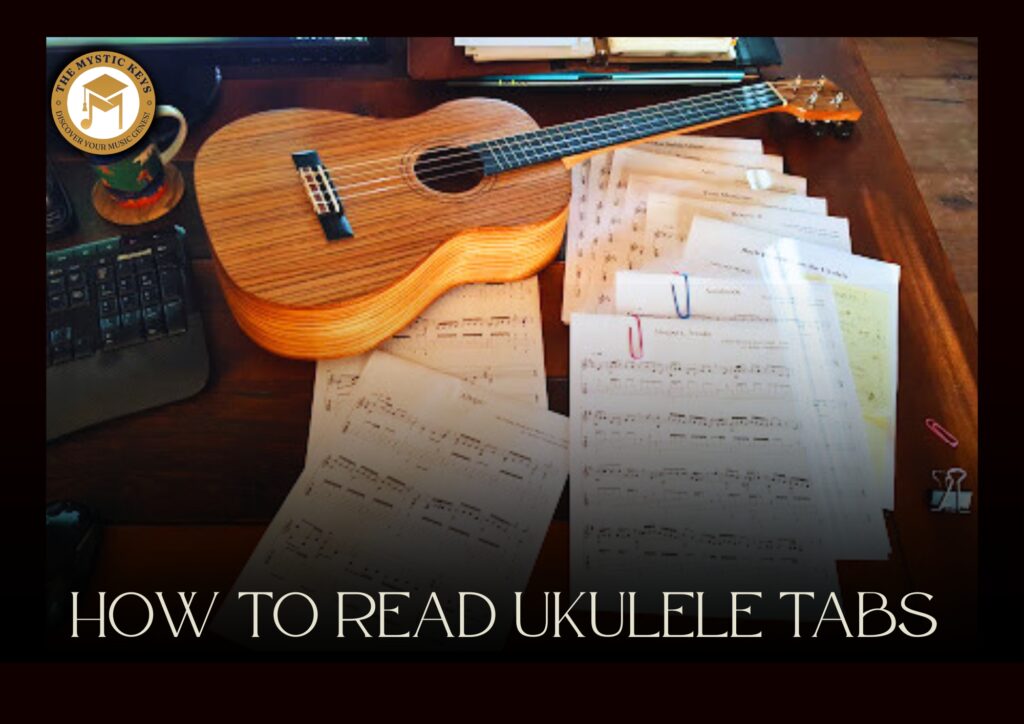How to Read Ukulele Tabs |A Complete Beginner’s Guide
Learning to play the ukulele is an exciting journey that can bring both joy and fulfillment. It is one of the most beginner-friendly stringed instruments, with its cheerful sound and easy-to-learn chords. However, like any musical instrument, the key to becoming proficient lies in understanding how to read music—specifically, ukulele tabs.
If you’re just starting out on your ukulele journey, understanding how to read ukulele tabs is essential to playing the songs you love. This beginner’s guide will take you through every aspect of ukulele tabs, from their layout to the different techniques and symbols used. By the end of this guide, you’ll be able to confidently read and play ukulele tabs, opening up a world of musical possibilities.

What Are Ukulele Tabs?
Ukulele tabs are a form of musical notation that is much simpler to read than standard sheet music. Tablature (or “tab” for short) is designed specifically for stringed instruments like the ukulele, guitar, and bass, and it tells you exactly which frets to press on which strings.
Unlike traditional sheet music, which uses notes to represent pitches, tabs use numbers on lines to indicate which fret to press down on a particular string. The layout of the ukulele tab is also very intuitive, allowing beginners to jump right in and start playing their favorite songs with minimal effort.

Understanding the Layout of Ukulele Tabs
A ukulele tab consists of six horizontal lines, each representing one of the four strings on the ukulele. You’ll notice that the bottom line represents the A string (the string closest to your feet when you hold the ukulele), and the top line represents the G string (the string farthest from your feet).
Here’s a basic visual layout of a ukulele tab:
In this example:
The A string (the bottom line) is represented on the lowest line, and it is the first string when you hold the ukulele.
The E string is the second line, the C string is the third line, and the G string is represented by the fourth (top) line.

Breaking Down the Numbers
In a ukulele tab, each number corresponds to a fret on the ukulele neck. For example, a “0” means that you play the open string (without pressing down any frets). A “1” means you press down on the first fret, “2” means the second fret, and so on.
Here’s a breakdown of some numbers you might encounter:
0: Play the string open (without pressing any frets)
1: Press down the first fret
2: Press down the second fret
3: Press down the third fret
4: Press down the fourth fret
X: Mute the string (don’t play it or mute it with your left hand)
For example, if you see “2” on the C string, that means you should press down on the second fret of the C string. If you see “0” on the A string, that means you play the A string without pressing any frets (open string).

How to Read Ukulele Tabs: Step-by-Step
Let’s walk through how to interpret the following ukulele tab:

-
Start with the top string, the G string (the fourth line).
The first note is “0,” meaning you play the G string open, without pressing down on any fret. -
Move to the second string, the C string (the third line).
The first number is “2,” meaning you press the second fret of the C string. -
Next, read the third string, the E string (the second line).
The first number is “0,” so you play the E string open. -
Finally, check the bottom string, the A string (the first line).
The first number is “0,” so you play the A string open.
So, the first section of this tab would sound like this:
-
G string open
-
C string, second fret
-
E string open
-
A string open
Continue reading the tab from left to right, following the same steps.

What Does a Ukulele Tab Tell You?
A ukulele tab will give you several important pieces of information:
Which string to play:
Each line corresponds to a different string, and the numbers on those lines tell you which fret to press. The tab layout ensures that you know exactly where to place your fingers.The order in which to play the strings:
Ukulele tabs are written left to right, just like reading a book. This means that you’ll play the notes in the order that they appear. If there are numbers stacked vertically, you’ll play all of them at once (like a chord).How to play the strings:
Ukulele tabs show you which strings to play and where to place your fingers, but they typically don’t indicate rhythm or strumming patterns. You’ll need to either listen to the song to get the rhythm or look for accompanying notation that shows you how to strum or pluck.

Common Techniques in Ukulele Tabs
In addition to reading basic fret numbers, ukulele tabs can also include other musical techniques. Here are a few to look out for:
Hammer-ons (h):
This technique is used to play a higher note by “hammering” down on a fret without plucking the string again. For example, “5h7” means you play the fifth fret and then hammer on to the seventh fret without plucking the string again.Pull-offs (p):
The opposite of a hammer-on, a pull-off involves playing a note and then “pulling” your finger off the fret to produce a new note. For example, “7p5” means you play the seventh fret and then pull off to the fifth fret.Slides (/ or ):
A forward slash (/) indicates a slide up to a higher fret, and a backslash () indicates a slide down to a lower fret. For example, “5/7” means you slide from the fifth fret to the seventh fret on the same string.Palm Muting (X):
When you see an “X” on the tab, it means to mute the string by lightly resting your left hand on it, producing a muted sound when strummed. This is commonly used to create percussive effects in a song.

Reading Chords in Ukulele Tabs
In ukulele tabs, chords are usually represented by stacked numbers. If you see numbers stacked vertically, it means you need to play all those strings at once, just like you would strum a chord.
For example:

This is a G chord. You would press the third fret on the G string and let the other strings ring open.

Tips for Reading Ukulele Tabs
-
Start with Simple Songs:
Start with simple and slow songs to get the hang of reading ukulele tabs. Songs with just a few chords or simple melody lines will help you build confidence. -
Learn Basic Chords:
Familiarizing yourself with basic ukulele chords (such as C, G, F, and Am) will help you read tabs more easily, as they’re often used in songs. -
Use Online Resources:
Many websites and apps offer free ukulele tabs for popular songs. Websites like Ultimate Guitar, Ukulele Underground, and others provide thousands of tabs for all levels. -
Listen to the Song:
Tabs don’t indicate rhythm, so listening to the song will help you understand the timing and feel. You can also play along with the original recording to match the rhythm. -
Practice Regularly:
Reading ukulele tabs gets easier the more you practice. Start slowly and focus on accuracy. Over time, you’ll become more comfortable reading tabs and playing along.

Conclusion
Learning to read ukulele tabs is an essential skill for any ukulele player, and it’s especially beneficial for beginners. By following the simple rules outlined in this guide, you can quickly start reading and playing your favorite songs. Ukulele tabs provide a simplified way to understand the fretboard and make music accessible to players of all levels.
With a little practice and patience, you’ll be able to dive into more complex songs and play along with ease. Whether you’re strumming chords or plucking melodies, mastering ukulele tabs will unlock endless possibilities for your musical journey.
Ready to go further? Join The Mystic Keys and explore our Ukulele Lessons Online—designed to help you grow from beginner to confident player, one chord at a time. Happy playing!
Related Blogs
How to Learn Ukulele Step by Step | A Comprehensive Guide
The ukulele is a delightful and accessible instrument that has become increasingly popular due to its cheerful sound, portability, and simplicity. Whether you’re picking up the ukulele for the first time or looking to refine your skills, taking the time to learn ukulele step by step will help you build a strong foundation.
Ukulele Sizes | Soprano, Concert, Tenor
& Baritone
The ukulele is a fascinating instrument with a bright, cheerful tone that has captivated musicians for generations. Originally from Hawaii, it has grown into a global favorite across various musical genres, from pop and folk to jazz and classical.
How Long Does It Take to Learn
the Ukulele?
The ukulele is often considered one of the most beginner-friendly instruments, yet it also offers incredible depth for advanced players. Its light, breezy tone and easy portability make it a popular choice for musicians of all levels.








